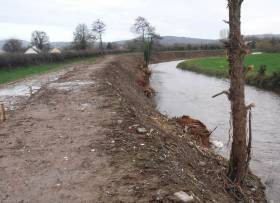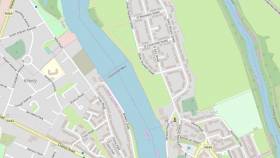Displaying items by tag: Limerick
Waterways Ireland advises masters of vessels on and users of the Shannon Navigation that the waiting jetty at the Railway Bridge in Limerick has been relocated to George’s Quay.
The jetty will be reinstated to its original location in March 2024 in time for the end of the winter period on Ireland’s inland waterways.
Shannon Navigation: Reinstatement of Railway Bridge Waiting Jetties in Limerick After Winter Period
Waterways Ireland advises masters of vessels and waterway users on the Shannon Navigation that the waiting jetties at the Railway Bridge in Limerick will be reinstated at the end of March.
As previously reported on Afloat.ie, the jetties had been relocated to Georges Quay from the end of October last year for the winter period.
Shannon Navigation: Winter Relocation of Railway Bridge Waiting Jetties in Limerick
Waterways Ireland advises masters of vessels and waterway users on the Shannon Navigation that the waiting jetties at the Railway Bridge in Limerick will be relocated to Georges Quay from Saturday 29 October.
These jetties will be reinstated to their original location in March 2023, the cross-border body for Ireland’s inland waterways adds.
Limerick Councillor Lambasts Fisheries Officials Over Illegal Poaching of Wild Salmon From Shannon
A Limerick councillor has hit out at what he branded as the “utter incompetence” of inland fisheries officers after images circulated on social media of as many as 60 salmon allegedly poached from the River Shannon.
As the Limerick Leader reports, the images show the the wild salmon lined up in a front garden, with three men alongside giving thumbs up.
It’s understood that the salmon are thought to have been illegally netted from the tail race at the Ardnacrusha hydro-electric plant.
Commenting on the images, Cllr Emmett O’Brien did not mince his words as he directed his ire at Inland Fisheries Ireland (IFI).
“The dogs in the street know that poachers are putting out nets and catching salmon swimming in the tail race,” he said, adding that there is a black market for such salmon throughout Limerick city.
“But bizarrely the IFI officers rarely if ever patrol the tail race but rather seem intent to race up and down the river in large power boats like Navy Seals.”
IFI says it is “currently investigating the circumstances of this incident and is therefore not in a position to comment further at this stage”.
The Limerick Leader has more on the story HERE.
Residents of a Limerick suburb on the banks of the River Shannon say they were not consulted about plans for a new kayaking facility in a local park.
As the Limerick Leader reports, locals close to Shannon Fields have hit out at the proposals for a fenced-off hard stand and storage unit for the Limerick Kayak Academy on park lands provided by Limerick City and County Council.
Speaking for the residents of the neighbouring Irish Estates, Cllr Frankie Daly said: “The lack of consultation is beyond a joke.”
Their campaign has the support of former champion rower Maxine Murphy, who suggests that Curragower Falls in the city centre would be a better location for the kayakers' needs.
But the council counters that residents will have every right to express their opinions as part of the planning process.
The Limerick Leader has more on the story HERE.
Proposal for ‘Shannon Greenway’ to Connect Limerick with Lough Derg
A working group has been established to develop a proposal for a Shannon Greenway connecting the city of Limerick with Lough Derg.
Waterways Ireland says it is working together with Clare County Council, Limerick City & County Council and others on the plans, which are still at an early concept stage.
However, it is understood that the working group has already been charged with examining possible route options and designs, as well as environmental considerations, costs and funding sources.
Also being considered is whether public lands between Limerick and Tuamgraney/Scarriff in Co Clare — especially the towpaths of the Park and Erinagh Canals and various ESB embankments — could be used for the project.
OPW Flood Works On Limerick River Show ‘Disdain’ For Natural Heritage Claims Wildlife Group
The Office of Public Works has been accused of showing “disdain” for Ireland’s natural heritage over flood relief works on a waterway in Co Limerick.
The Irish Wildlife Trust (IWT) criticised the clearing last year of some 3km of wild habitat from the River Newport, east of Limerick city and within the Lower Shannon SAC.
The conservation group accuses the OPW of conducting the clearance works — in which “entire stretches of the riverbank had been stripped down to bare soil” — in the absence of the Appropriate Assessment legally required under Irish and EU law.
It is suggested these works have jeopardised an important habitat for otters and wet Willow woodland, while also potentially exacerbating the spread of invasive plan species such as Japanese knotweed and giant hogweed.
The IWT says it visited the River Newport in December and found that “works had greatly exceeded what had been set out” in the OPW’s initial screening report, which the group has branded “largely inaccurate”.
IWT campaigns officer Pádraic Fogarty said: “The OPW is not above the law but yet it seems to think that it can operate with impunity. The damage it has done to our rivers is incalculable; this instance at the Newport in Limerick is not untypical of the distain they show for our natural heritage.”
Similar complaints have been levied against OPW works in Skibbereen, where a stream feeding the River Ilen has been re-engineered as a concrete culvert.
This used to be a small stream feeding into the river Ilen in Skibbereen, home to masses of invertebrates, small trout and sticklebacks, otters and herons, bankside wildflowers, trees and vegetation. This is it after @opwireland finished with it. Absolutely criminal! pic.twitter.com/AEXqLm0oQW
— Ireland's Wildlife (@WildIreland) May 11, 2019
The OPW did not respond to queries from either The Sunday Times or The Green News.
Girl In Hospital After Boat Overturns In Limerick City
RTÉ News reports that a 12-year-old girl was hospitalised after an incident on the River Shannon in Limerick city yesterday morning (Saturday 23 February).
It’s understood that she was one of four girls on a boat that overturned in the river near the Old Salmon Weir.
The casualty became trapped underneath as her hair tangled with the boat’s outriggers, according to BreakingNews.ie.
An eyewitness said the girls’ rowing boat was in a fast current and had broken in two.
“I’m haunted all day. It’s the screams. I can still hear the girls screaming, ‘help, help help’,” said local man Danny Ryan, who rang 999 as he watched the scene unfold.
The casualty was freed from the boat by a team of firefighters trained in river rescue who were alerted while on patrol at the time.
Elsewhere, the Irish Coast Guard were involved in a ‘difficult’ rescue of two people from Poll na Péist on Inis Mór in the Aran Islands, which previously hosted the Red Bull Cliff Diving World Series.
Glory for Limerick at Indoor Rowing Blitz
#Rowing: Salesian Secondary College in Limerick won the Open/Club boys section of the All Ireland Indoor Rowing Blitz in Trinity College Dublin today. The Limerick school had a best time of 6 minutes 22.4 seconds for the 2,000 metres on the ergometer. Another Limerick school, Laurel Hill College, topped the under-18 girls’ rankings. The best under-16 boys and girls came from Sutton Park School. Competitors from as far away as Skibbereen in Cork travelled to the event.
Carlow mentor Kathryn Wall and Dominican College, Griffith Avenue in Dublin, received special presentations.
All-Ireland Indoor Rowing Blitz, Trinity College (Selected Results; winners)
Boys
Open/Club: Salesian One, Limerick 6 min 22.4.
Under-16: Sutton Park School 6:37.8.
Girls
Open/Club: Laurel Hill 6:43.5
Under-16: Sutton Park School 8:03.1
Limerick Riverfest Kicks Off Today For May Bank Holiday Weekend
#Festivals - Limerick becomes a mecca for watersport enthusiasts this May Bank Holiday weekend for the city’s Riverfest 2017, which kicks off today (Friday 28 April).
Highlights of the city’s premier summer maritime festival include the Riverfest BBQ Competition, the Riverfestival village in Arthur’s Quay Park, the Barringtons Hospital Great Limerick Run, a spectacular fireworks display.
At the centre of it all is the Maldron Hotel Riverfest on the Shannon, featuring wakeboarding with Irish champion David O Caoimh and pro jetboarders Scotty Knemeyer and Bo Krook, as well as the River Shannon Zipline between Arthur’s Quay and Honan’s Quay for more thrill-seeking visitors.
Exciting and skilful displays by Limerick Marine Search and Rescue, the Defence Forces, Foynes Yacht Club, Limerick’s numerous rowing clubs and yachting and sailability groups will mean all eyes will be firmly focused on the water.
For full details of the festival lineup visit the official website HERE.
And don’t forget the Dublin Port Riverfest that returns for the June Bank Holiday, as previously reported on Afloat.ie.




























































